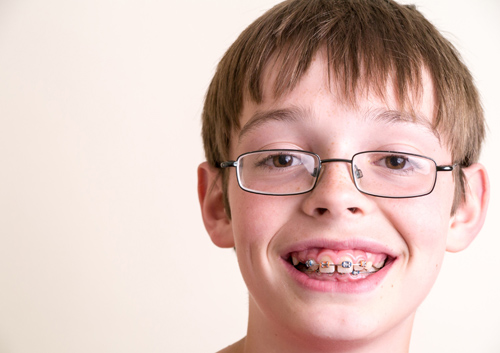April 17th, 2024

Did you know there are as many types of dental fillings as there are flavors of ice cream? Okay, maybe that’s an exaggeration. Still, when you visit the dentist with a cavity, there are many filling options. Most of us just sit in the chair, open our mouths, and let the dentist work his or her magic. But have you ever stopped to consider what the dentist is filling and restoring your decayed or broken tooth with?
Five types of dental fillings
There are five basic kinds of dental filing material. The dentist decides which type to use based on the degree of the decay, the cost of the material, and the type of dental insurance you have.
- Dental amalgam, or silver fillings, have been used to fill cavities for more than 150 years. Dental amalgam is the most common type of dental filling. It's strong, durable, and less expensive than other types.
- Composite fillings, or white fillings, are popular because the color matches the rest of your teeth. Composite fillings are a combination of resin and plastic. They are more aesthetically pleasing than silver fillings, but are also less durable.
- Ceramic fillings are durable and visually appealing (tooth-colored), but they are expensive. They are made of porcelain and have been shown to be resistant to staining.
- Glass ionomers are typically used on children whose teeth are still changing. Constructed from glass and acrylic, glass ionomers are designed to last fewer than five years. The benefit of these dental fillings is that they release fluoride, which protects the changing tooth from further decay.
- Unless you’re a rock or movie star, gold fillings aren’t common. While a gold filling is durable, non-corrosive, and can last more than 15 years, it not only takes more than one dental visit to place, but, as you can imagine, it is expensive.
For more information about fillings, or to schedule an appointment with Dr. Lapsi, please give us a call at our convenient Carlsbad, Mission Viejo, or Laguna Hills office!
April 10th, 2024

Perhaps you had a particularly irritating commute home from work, and you realize at the end that your jaw was clenched tight the entire time. Or maybe you grind your teeth when you are nervous or anxious about an upcoming business meeting. Most people grind their teeth from time to time, but it’s important to recognize the signs and symptoms of chronic tooth grinding. Known as bruxism, this condition can lead to oral health problems and dental issues later.
Signs and symptoms of bruxism
- Your partner might complain about the fact that you grind your teeth while you sleep. People who grind their teeth on a regular basis often do so during the night, and aren’t necessarily aware it is happening. However, your partner will more than likely notice if you develop this condition. If he or she mentions that it happens often, you might want to contact our team at Excel Dental and Orthodontics.
- You may experience a persistent and unexplained headache if you grind your teeth too often. You may not realize why you have this headache, because you are not aware of the fact that you have been grinding your teeth. Take note of any headaches you have, and if you cannot attribute them to another source, please give us a call to set up an appointment with Dr. Lapsi.
- Your jaw will more than likely become sore if you suffer from bruxism. If you wake up in the morning and have any discomfort in your jaw, you might have spent the night grinding your teeth. Our team can give you tips and advice for managing bruxism.
While many people associate their teeth grinding with stress, it actually is caused more often by crooked teeth, an overbite, or an under bite. If left untreated, bruxism can lead to a variety of complications, including dental injuries, hearing loss, and the onset of TMD. If you think that you might be a chronic tooth grinder, it might be time to set up an appointment at our Carlsbad, Mission Viejo, or Laguna Hills office in order to find out which treatment options are available to you.
April 3rd, 2024

There are many great reasons to see an orthodontist. For a healthier bite. For straighter teeth. For a more confident smile. So why are you hesitating? If the visibility of traditional braces is what’s holding you back, ask Dr. Lapsi about lingual braces.
With regular braces, brackets are bonded to the front of each tooth with a special adhesive. Ligatures around each bracket or bracket clips grip an archwire, which does the work of moving the teeth. The gentle pressure from the wire guides the teeth into alignment in gradual stages. Every adjustment moves the teeth to their perfect positions. These braces are quite effective—and they are usually quite visible.
Lingual braces, on the other hand, are virtually invisible. Lingual means “toward the tongue,” and this placement is the difference between lingual braces and more traditional types of orthodontic braces.
Lingual braces are custom designed to be applied to the inside of your teeth. Specially designed brackets are attached to the backs of the teeth. Individually crafted archwires are used to guide your teeth to their best alignment.
Lingual braces can be the solution to many orthodontic concerns:
- If you need or want invisible braces for personal or professional reasons, lingual braces are a great option. Because they are behind your teeth, they are even less noticeable than clear aligners—and you don’t need to keep track of your hours wearing them.
- Lingual braces keep the front of your teeth braces-free for playing a brass or reed instrument, or for participating in sports. (Just remember, a mouthguard is always a good idea for athletic activities, and especially when you wear braces.)
- Both brackets and wires can be customized to fit your teeth perfectly, and new lingual brackets and wires are more comfortable than ever.
You might be a good candidate for lingual braces if:
- You have a large enough tooth surface to place a bracket. Adults with small teeth—or children—might not be have enough room on the back of each tooth to hold a bracket.
- You don’t have a major malocclusion (bite problem) which would make lingual braces impractical. A deep overbite, for example, could cause the wires and brackets behind the upper teeth to come loose or detach as they come in contact with lower teeth.
- You are dedicated to keeping up with your oral hygiene. Because wires and brackets are behind the teeth, it can be harder to keep them free from food particles and plaque.
Finally, even if lingual braces aren’t the perfect match for your orthodontic needs, there are other options that can work for you. Smaller metal brackets, ceramic brackets that blend in with your enamel, and clear aligners mean today’s orthodontic work is more subtle and discreet than ever before.
For a healthier bite, for straighter teeth, for a more confident smile—don’t hesitate. Contact our Carlsbad, Mission Viejo, or Laguna Hills office to discuss the many great options you have available to give you the smile you’ve always wanted—front and center.
March 27th, 2024

The average age of individuals who get braces is between nine and 14, although it is appropriate for younger children to visit Excel Dental and Orthodontics for a consultation with Dr. Lapsi. While parents may be concerned about the efficacy of early orthodontics, research suggests that early intervention can prevent greater dental health problems later in life.
What types of conditions require early intervention?
According to the American Association of Orthodontists, 3.7 million children under the age of 17 receive orthodontic treatment each year. Early intervention may be appropriate for younger children with crooked teeth, jaw misalignment, and other common issues. Early orthodontic treatment may be of use for several types of problems:
- Class I malocclusion. This condition is very common. It features crooked teeth or those that protrude at abnormal angles. In general, early treatment for Class I malocclusion occurs in two phases, each two years long.
- Class III malocclusion. Known as an underbite, in which the lower jaw is too big or the upper jaw too small, Class III malocclusion requires early intervention. Because treatment involves changing growth patterns, starting as early as age seven is a smart choice for this dental problem.
- Crossbite. Crossbite occurs when the upper and lower jaws are not properly aligned. An orthodontic device called a palatal expander widens the upper jaw, allowing teeth to align properly. Research suggests that early treatment may be beneficial in crossbite cases, especially when the jaw must shift laterally to correct the problem.
- Tooth extraction. That mouthful of crooked baby teeth can cause problems when your child’s permanent teeth erupt. For kids with especially full mouths, extracting baby teeth and even permanent premolars can help adult teeth grow in straight.
Considerations when thinking about early intervention
Early intervention isn’t helpful for all conditions. For example, research suggests that there is little benefit to early orthodontics for Class II malocclusion (commonly known as an overbite). Instead, your child should wait until adolescence to begin treatment. Scheduling a visit to our Carlsbad, Mission Viejo, or Laguna Hills office when your child is around age seven is a smart way to create an individualized treatment plan that addresses unique orthodontic needs.










